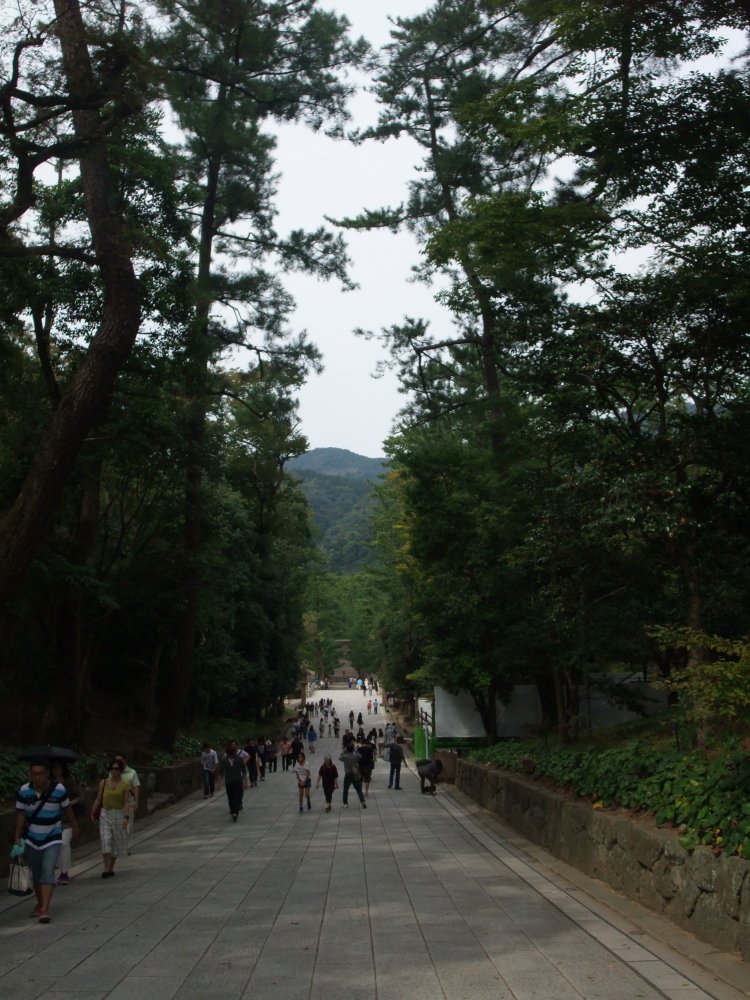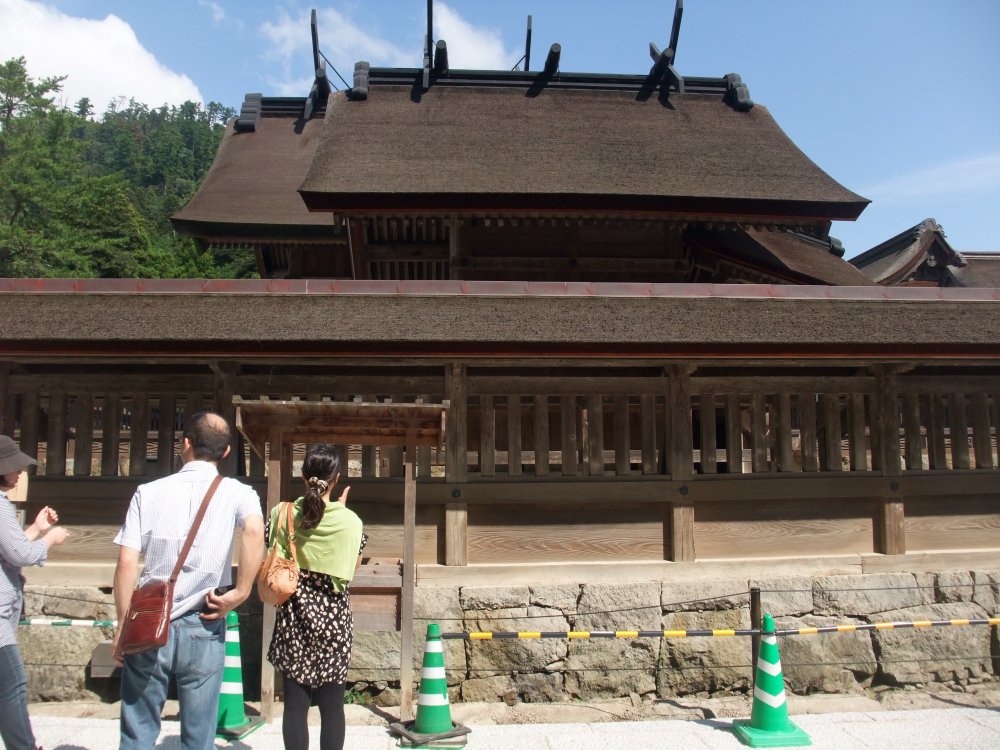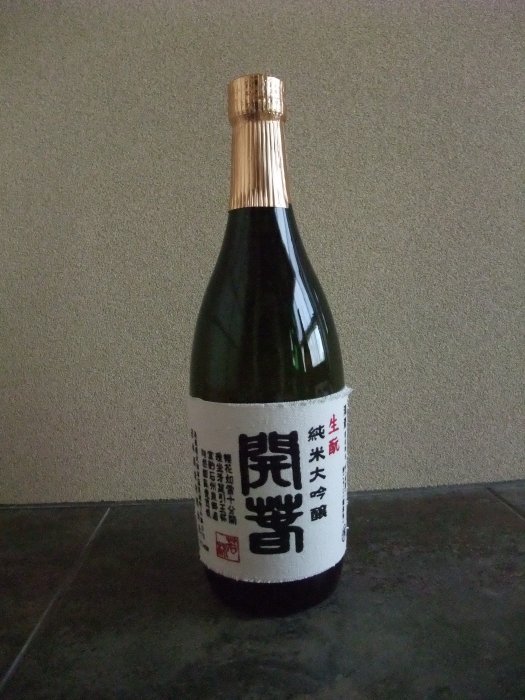
Rediscovering Japan
Travel (Izumo (Shimane))

by tomizuta

People walking along the main entrance road to Izumo Taisha. Note the woods
in the far back, typical site for a Shinto shrine
One area that I had never visited was the
San-In area. San-In area is the northern part of western Honshu, basically, from west
to east, the northern part of Yamaguchi prefecture, Shimane prefecture,
Tottori prefecture and the northern part of Hyogo prefecture, facing the
sea of Japan. Tottori and Shimane are the two most
sparsely populated prefectures in Japan.
We travelled to Shimane for five days in
September 2015. The places of interest for me was, Adachi art museum, Matsue, Izumo, Iwami
silver mine (now depleted and a World Heritage site), and Yunotsu. Adachi art museum is renowned more for its fabulous Japanese garden, which
can be viewed from within the museum only. I will skip further explanation, as one can find so many articles easily
on the internet.
Izumo City is situated 20 miles east of
Matsue City, the capital of Shimane prefecture. Izumo, which means emerging clouds, is the old name of the entire area
of northern Shimane and part of Tottori prefecture facing the Japan Sea.Izumo is full of stories from the age of the gods. Legend says that a god took pity seeing how small Izumo was. He tugged
some islands and land to Izumo to enlarge the area. It is said that one third of Japanese
mythology is based in Izumo. No wonder that Izumo is regarded as the land of mythology.
There have been many discoveries of tombs and ritual sites in the area,
a particular one being Kojindani, In 1985, the largest trove of ritual
bronze swords together with bronze spears and bells were discovered. They
come from the Yayoi era (3rd century BC-3 rd century AD) before the formation
of the current monarchy in circa 5th century AD. They are now on display
at the Shimane Museum of Ancient Izumo, adjacent to the Izumo Taisha.
Izumo Taisha is one of 16 prominent Shinto
shrines that receive periodical messengers from the imperial family. Legend says that in October, all the gods in Japan would convene in Izumo,
where they would discuss matchmaking. As all the gods are away, October
was called Kannnazuki, meaning No God Month in Kanji (Chinese characters). That is the reason many travel to Izumo Taisha to pray that they may be
lucky enough to be introduced to a good new partner, for dating or business.
All Shinto shrines are dedicated to a
particular god or deceased heroes. The Toshoguu in Nikko, a World Heritage site is dedicated to Ieyasu Tokugawa,
the founder of the Tokugawa Shogun family that governed Japan for more
than 250 years from early 17th century to the middle of the 19th century. He was worshipped as a god after
his death.
Izumo Taisha is dedicated to Ookuninushi-no-oomikami (the great god Ookuninushi),
who took part in the founding of Japan. One legend suggests that since
he was the father of Japan, that is why people pray to him for the opportunity
to meet good partners. Reference to Izumo Taisha appears in Kojiki, the
earliest written document on Japanese history and legends, composed in
the early 8th century. The throne for the god is called goshinza,
and the building housing the throne, honden (main building).

View of the main temple (honden)of Izumo Taisha
At the most prestigious Shinto shrines, the honden are refurbished from
time to time to renew the home for the god. The interval is typically 20
years, but in the case of Izumo Taisha, every 60 to 70 years. The architecture style of the honden of Izumo Taisha is called Taisha-zukuri,
the oldest architecture style of Shinto shrines, the main feature of which
is its raised flooring (Takayuka). Takayuka is a feature of storage buildings in the Yayoi era (3rd century BC to 3rd century AD), when rice growing started in Japan, and raised floor storage
buildings were built to store the rice. The purpose was to protect the
rice from flooding and pests. One theory is that Taisha-zukuri, with its raised floors, was a development
from Takayuka storage buildings to a ritual spiritual shrine to offer the
harvested rice to the gods. In any event, the architecture is further evidence
that Izumo Taishafs origin goes back to the very early days of Japan.
We spotted a smaller shrine off the main
entrance road to the Taisha, close to the 2 car parks on the west. It was a
shrine commemorating Nominosukune, who is said to be the founder of Sumo
(Japanese wrestling). He is a legendary character, supposedly a Japanese Hercules. I will explain more about Shinto shrines
and Sumo in the article on Suwa (Nagano).
Something you should not miss in Izumo is Izumo soba (buckwheat) noodles,
one of the three most famous soba noodles in Japan, the other two being
Wanko soba (Iwate) and Togakushi (Nagano). Raw soba noodles are boiled and then served
either cold or warm. Cold soba is called Mori. It is just the soba noodles with the accompanying
dipping sauce. You eat the noodles after dipping it in the sauce. If the
soba comes with nori (seaweed) topping, it is called Zaru. If you wish
to enjoy soba cold, ask for Mori or Zaru. Otherwise, the noodles are served warm in soup. This is called Kakesoba.
If you wish to have a topping such as Tempura, it becomes Tempura soba.
Izumo soba is unique. The most typical is Warigo-soba. This is served cold and usually in three
layers of wooden bowls (Warigo) one atop the other. Contrary to Mori or
Zaru, where you dip the noodles in the sauce, you pour the sauce on to
the top layer of noodles together with the garnish provided. Once you finish
the top layer, you remove the Warigo and pour the sauce left in the top
Warigo, and add more sauce and garnish. I understand that buckwheat is grown on poor soil. The local buckwheat
was grown in Oku-Izumo, the southern mountainous area. Always ensure that
the soba is made of local buckwheat to enjoy the most.

Warigo Izumo soba
We then travelled to Iwami Ginzan, a former
silver mine that produced one third of world output in the 17th century and is now a World Heritage site. I will skip talking further about Iwami,
except to mention that the mine town of Omori has also been designated as an Important Preservation District for Groups of Historic
Buildings, in this case as a mining town.
On the way back to Izumo airport, we paid a brief visit to Yunotsu village
to the north of Iwami silver mine, on the Japan Sea coast. Yunotsu is part
of the Iwami Ginzan related World Heritage site. Yunotsu served as the port for the Iwami silver, and its onsen (hot spa)
lodgings and entertainment district flourished during the peak days of
the mine. It is another Important Preservation District for Groups of Historic Buildings,
for the port and onsen lodgings.
We strolled through
the narrow roads with onsen ryokan on both sides, and found a Sake brewery in
the village selling the brand Kaishun.
I chatted with the salesperson and bought a 300ml bottle of Honjozo grade.
It is a relatively dry Sake, that will go well with any type of dish, and
good value for money.

720 millilitre bottle of Kaishun junmai daiginjo from Yunotsu
back to top page






